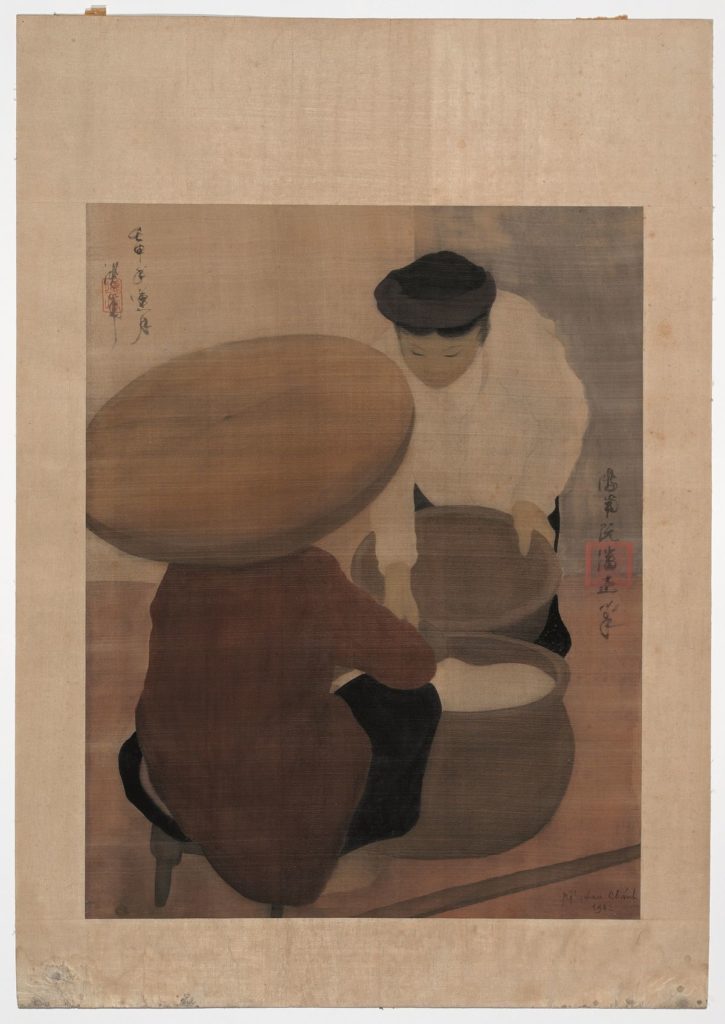Nguyen Phan Chanh, 1932, « La Marchande de Riz »
Nguyen Phan Chanh’s early works are considered to be icons of Vietnamese art. Some of the most widely acknowledged include:
Choi O An Quan (Game of O An Quan); Len Dong (The sorcerer); Rua Rau Cau Ao (Washing vegetables by the pond); Em Be Cho Chim An (Little girl feeding the bird). These works were critically acclaimed, widely published and collected in 1931-1932. They quickly became the cornerstone images of Vietnamese painting.
La Marchande de Riz (The Rice Seller) is one of such early work dated 1932. It was sent by the artist himself under the authority of Victor Tardieu, Director of the Indochina Fine Art School to the AGINDO, (Agence économique de l’Indochine), a Parisian organisation dedicated to the promotion of Vietnamese artists out of Vietnam. With its Gadin frame (named after the frame maker), the painting was then exhibited in Napoli, Italy (Seconda Mostra Internazionale d’Arte Coloniale, 1934).

On the back of the label we still can find a reference to the Naples’ Colonial Exhibition where it was exhibited and priced at 2000 French francs in 1934 (1500 euros nowadays…)
Nguyen Phan Chanh was 40 years old when he painted it and he graduated from the Indochina Fine Art School only two years earlier in 1930. He was the eldest student of the first class as his fellow students (Le Pho, Mai Trung Thu, Le Van De, Nguyen Tuong Tam…) were half his age, a felt generation gap.
While many in the younger generation had to find (at least to think) their way to Paris, the world center for art, to build their artistic careers, Phan Chanh’s just kept working on Vietnam and Vietnamese sceneries.
He was born in the center of Vietnam in the Ha Thinh Province on July 21st 1892, in a city called Trung Ties. He was educated by his father, a Confucian scholar, till the âge of 7 when his farther died. He then had to help his mother by selling his drawings in the markets and he started drawing from photos he was presented with. Later on, he taught Chinese writing and in 1922, he entered the Hue Pedagogy School. He graduated in 1923 and started teaching in Dong Ba Primary School in Hue, Central Vietnam. He was the only candidate from the central region of Vietnam to be admitted in the first batch of students at the Indochina Fine Art School, in 1925. As early as 1928, he designed a post stamp. At the same time, encouraged by Victor Tardieu and Nam Son, he developed an interest in silk painting. The main technical challenge in silk painting is that gouache and ink cannot be altered after the application on a silk crepon laid down on thick paper.
Everything is classic in the artist’s usual work: its dimensions (64.5 X 50.5 cm), its signature, dating and stamp.
Timeless Elegance…
La Marchande de Riz (The Rice Seller) illustrates perfectly the talent of a painter at his best, painting the simple but evocative subjects of commoners engaged in small trades or other equally timeless moments in Vietnamese life.
One recalls the lines written in Nguyen Phan Chanh’s diary:
“Going out painting at dawn, I usually walked along rivers and canals. Once, I passed by a girl washing vegetables at the water’s edge, her white shirt and black trousers only half-glimpsed in the morning mist. It was dreamlike and really beautiful. And I always like misty, dreamlike and poetic scenes.”
These lines perfectly describe the artist’s approach to the painted subject. Beyond the specificity of the subject, Nguyen Phan Chanh applies a style of his own with strong and solid masses, for example the hat of the seller or her huge basket, with no superfluous decoration, in a style close to traditional and popular Vietnamese woodcuts. Employing a subdued brown colour palette with ink strokes elegantly outlining the head gear and the trousers of his figures, the artist creates a clever geometry of triangles and circles, creating harmony of colours, lines and washes in the painting.
Painting the feet of the stool and the don gahn (used to carry to heavy bags of rice) enhances both vertical and horizontal spatial dimension in the painting. Nguyen Phan Chanh’s perfectionist tendencies are revealed in the elegance of the Chinese inscription and the way the painting is mounted, lower in the frame.
After 1933, he returned to his native province and will take over his own promotion and exhibit in the Hanoi Real Estate Bank and SADEAI (Société Annamite d’encouragement à l’art et à l’industrie).
In 1945, Nguyen Phan Chanh became an executive member of Ha Tinh Province Association for Salvation of National Culture where he took up the cause of the fight for independence. His journey mirrored that of many artists and other cultural workers of his generation. In those years, he painted propaganda and campaign posters, where the imageries and expression were vastly different from the timelessly classic silk paintings.
When he passed away in 1984 in Hanoi, his contributions to the artistic heritage of Vietnam was recognised and he received the highest posthumous award by the Socialist Republic of Vietnam: the Ho Chi Minh Prize in Literature and Art.
Jean-François Hubert